How to Create a Compelling Character Arc That Drives Your Story Forward
Ever heard the phrase, “a leopard can’t change its spots?” Well, in storytelling, we beg to differ. We thrive on it. A character arc is proof that even the most stubborn spots can fade, twist, or transform under the proper pressure.
Stories without arcs are like meals without seasoning; they might fill a gap, but they’ll never leave a lasting taste. A strong character arc isn’t just window dressing; it’s the driving force of the dialogue, the transformation that keeps readers and viewers glued to the page or screen.
Whether your hero falls from grace or climbs toward redemption, the emotional journey is what drives your story forward. So, why should you care about mastering the character arc? Because it’s what turns flat characters into characters who breathe and stories into experiences that resonate.
Let’s jump in and craft arcs that change everything.
The Art of Character Arc?
A powerful story isn’t just about what happens. It’s about who it happens to and how they change. That’s where the character arc comes in.
More than just a storytelling device, a character arc is the heartbeat of emotional truth. It’s the stretch of road your character travels from broken to whole, from proud to humbled, or even from hero to villain.
Through trials, heartbreak, revelations, and choices, they transform. Whether it’s a quiet awakening or a total unraveling, it’s not just about change; it’s about earned change.
So why does this matter?
- Because readers crave more than just twists, they want emotional satisfaction.
- Because transformation mirrors real life, we see ourselves in the struggle.
- Because arcs give your story shape, stakes, and soul.
The plot moves the story forward, but the character arc makes us feel it.
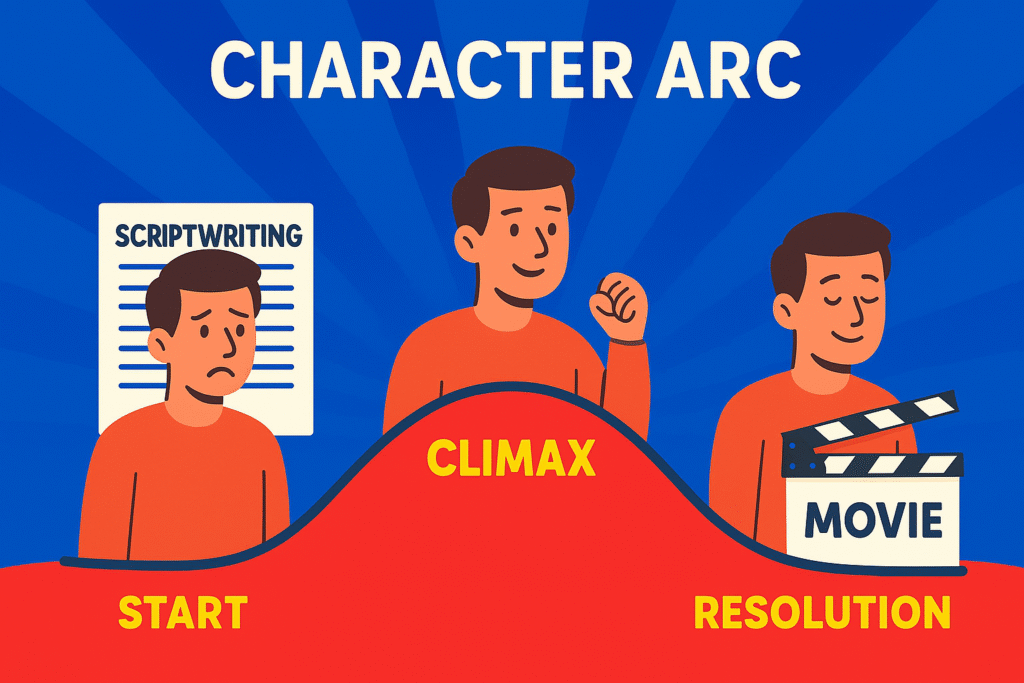
Dramatic Structure and the Character Arc: Three Acts, One Journey
Like a journey unfolding with each movement, most compelling character arcs unfold across a familiar tripartite structure:
Act One: The Setup and Spark
We meet our protagonist in their “normal.” Their flaws, fears, or ignorance are still intact. But soon, a trigger, the inciting incident, throws a wrench into the gears. It’s the slap that wakes them, the storm that rocks the boat.
Understanding Scene Structure in Screenplays: How to Build Powerful Moments on Screen
By the end of Act One, we’ve hit the first turning point, and the old world begins to crack. This pivotal moment forces the character to act, and we, the audience, lean in.
Example:
- Michael Corleone in The Godfather begins as an outsider to his family’s crime world. When his father is attacked, Michael’s quiet resolve begins to fracture.
Act Two: Rising Tensions and Deepening Change
This is where the rubber meets the road. Our character wrestles with mounting challenges, each one designed to chip away at their old self and introduce the possibility of growth or destruction.
They may:
- Develop new skills.
- Form surprising alliances.
- Face moral crossroads.
- Discover hidden strengths or weaknesses.
By late Act Two, self-awareness begins to surface, but it’s rarely complete.
Example:
Raskolnikov in Crime and Punishment begins to see that his theories about crime and morality don’t hold water as he grapples with guilt and consequence.
Act Three: Climax, Collapse, or Catharsis
The pressure cooker finally explodes. The dramatic question: Will they win, lose, or change? Is answered. The plot may resolve, but the character arc hits its emotional climax.
This is the aha! Moment, or sometimes the oh no! The character either becomes who they were meant to be, or tragically fails to evolve.
Examples:
- Jean Valjean in Les Misérables goes from hardened criminal to selfless guardian, guided by grace.
- In The Godfather Part II, Michael Corleone completes a tragic arc, from reluctant heir to ruthless patriarch, losing his soul in the process.
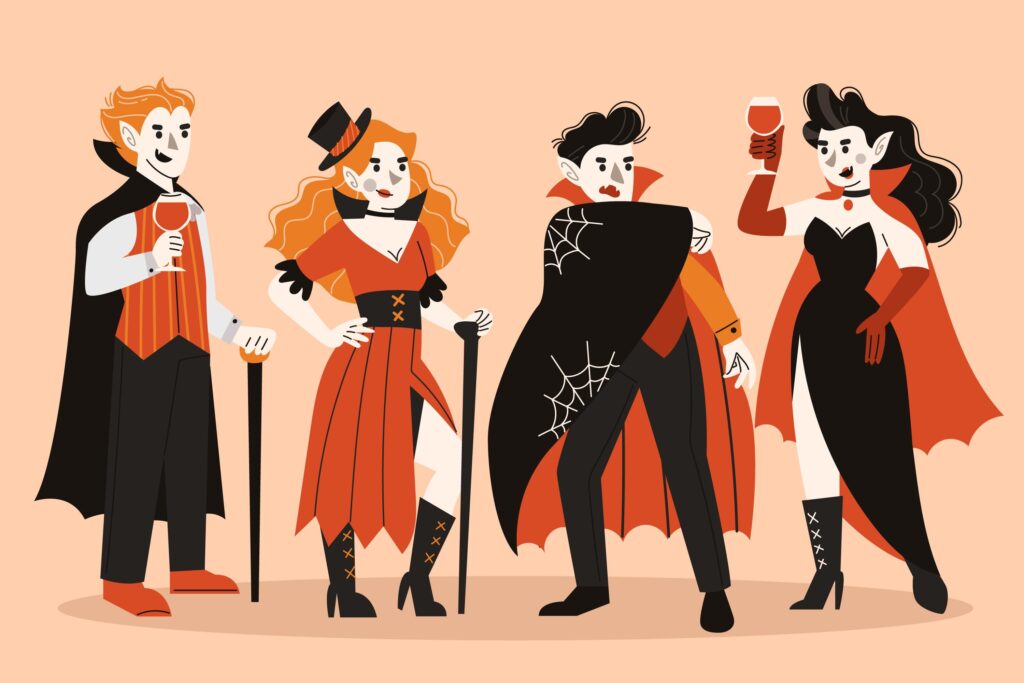
Examples of Character Arcs Across Media
Let’s take a look at some compelling examples of character arc in action across different media.
In Literature:
- Hamlet (Shakespeare): From philosopher-prince to revenge-obsessed, possibly mad soul.
- Les Misérables (Victor Hugo): Nearly every central character experiences a shift that redefines their fate.
In Film:
- Tootsie: Dustin Hoffman’s chauvinist learns empathy by walking a mile in high heels.
- Empire of the Sun: A boy’s innocence is lost amid the wreckage of war.
- The Godfather: Michael’s shift from civilian to don is one of cinema’s most chilling transformations.
On TV:
TV thrives on the long game. Character arcs often span seasons, making the changes richer.
- Desperate Housewives: Each woman transforms under pressure through scandals, secrets, and self-discovery.
- Xena: Warrior Princess: Gabrielle grows from naïve farm girl to seasoned warrior, earning her stripes and a legacy.
Why a Character Arc Matters to You
Here’s the million-dollar question: “Why should I care?” If you’re a writer trying to breathe life into your story, mastering the character arc will:
- Help you create memorable characters readers care about.
- Anchor your plot with emotional depth.
- Turn your story into a satisfying journey, not just a sequence of events.
Whether you’re writing a screenplay, novel, or short story, think of the character arc as your north star. It guides not just your characters but your readers through meaning, transformation, and impact.
The Power of the Character Arc
A well-executed character arc:
- Creates emotional resonance.
- Gives structure and purpose to the narrative.
- Reflects the human experience of growth, struggle, and change.
How to Write a Character Arc That Hooks Readers from Start to Finish
Let’s cut to the chase, you’re here because you want to write a character arc that doesn’t just sit there like stale toast. You want to stretch and transform. So let’s roll up our sleeves and build one step-by-step, from the ground up.
Think of a character arc like a journey down a curvy road. At the start, your character is standing at the edge, staring off into the unknown. They’ve got baggage, some they packed, some they didn’t ask for.
Along the way, they hit roadblocks, detours, and even crash a few times. But when they finally reach the end, they’ve changed. Maybe for the better. Maybe not. Here’s your roadmap:
Establish the Emotional Baseline
Before the fireworks begin, you need a spark. Ask yourself:
- What does your character believe at the beginning?
- What emotional wounds or personal flaws are they carrying?
- What do they want and what do they need?
This emotional baseline is your starting point, the version of your character before the plot puts them through the test.
Envision Their Destination
Now, jump ahead. Where do you want your character to land?
- Will they rise stronger and wiser?
- Will they spiral into ruin?
- Will they hold firm and influence others instead?
Knowing where your character arc is heading lets you steer every decision along the way.
Define the Heart of the Conflict
Conflict is the fuel of change. Without it, your character arc is all dressed up with nowhere to go.
There are two types to keep in your storytelling toolbox:
- Internal conflict: Fear of abandonment, guilt, shame, identity crisis.
- External conflict: War, betrayal, injustice, natural disaster.
The external forces shake the ground beneath their feet. The internal stirs the storm inside. Together, they force your character to either change or break.
Plot the Major Story Beats
Use the tried-and-true three-act structure to weave the arc into the plot like a master tailor.
Here’s the rhythm:
- Setup: Who is this character? What are their flaws or false beliefs?
- Inciting Incident: What rattles their worldview?
- Rising Action: How does the pressure mount? Do they resist?
- Crisis: What pivotal choice tests their limits?
- Climax: How is their final transformation challenged?
- Resolution: Who are they now?
With these beats, the character arc isn’t just riding shotgun; it’s steering the whole car.
Use Smart Tools to Track Arcs
Storytelling is an art, but managing arcs can be messy without the right tools. Use Celtx, a digital ally for modern screenwriters.
Here’s what you can do with Celtx:
- Create detailed character profiles.
- Map out arcs visually using storyboards.
- Attach key emotional beats to specific scenes.
- Collaborate live with co-writers.
How Character Arcs Drive Great Stories
Let’s hit the brakes for a second and talk big picture. Why do character arcs matter?
Because characters are the emotional anchors of your story, and transformation is the reward your audience came for.
Emotional Resonance is Everything
Readers and viewers don’t just follow characters, they feel with them. Watching someone fail, learn, and grow mirrors our real-life rollercoasters. That emotional reflection? That’s what sticks. No arc = no catharsis.
Plot Follows Character
Strong character arcs don’t just react to plot events; they shape them. The inner world of your character drives decisions that ripple outward and push the story forward like dominoes.
Arcs Bring Texture and Depth
Without change, characters feel one-dimensional. A good arc adds seasoning, whether it’s a redemption story, a descent into darkness, or a philosophical reckoning. They help:
- Support your theme.
- Reinforce tone.
- Keep your audience invested..
The 4 Basic Types of Character Arcs
Let’s break it down. Not all arcs are created equal. Here are four foundational arc types every writer should know:
The Positive Change Arc
This is the classic hero’s journey. Your character starts with a flaw or false belief, goes through trials, and comes out better, stronger and wiser.
Examples:
- Luke Skywalker (Star Wars: A New Hope): From farm boy to galactic hero.
- Harry Potter (Harry Potter series): From unloved orphan to brave protector.
Key traits:
- Begins as flawed or unsure.
- Experiences intense conflict and realization.
- Ends transformed and whole.
The Negative Change Arc
Also called the tragic arc. This character may start noble or at least neutral, but poor choices or pressure send them spiraling. Think corruption, downfall, or loss of soul.
Examples:
- Walter White (Breaking Bad): From teacher to kingpin.
- Michael Corleone (The Godfather): From outsider to ruthless mafia boss.
Key traits:
- Starts with potential.
- Slowly succumbs to flaw or fear.
- Ends broken, bitter, or beyond redemption.
The Flat Arc
Not all heroes need to change. In this arc, the protagonist holds firm in their beliefs. The world changes because of them, not the other way around.
Examples:
- Indiana Jones (Raiders of the Lost Ark): Indy stays Indy, but he shapes others.
- Furiosa (Mad Max: Fury Road): Her belief in hope transforms those around her.
Key traits:
- Consistent moral compass.
- Inspires growth in others.
- Tests but doesn’t abandon core values.
The Transformational Arc
This one’s deeper than a simple win-or-lose scenario. It’s philosophical, emotional. A shift in worldview, not just behavior.
Examples:
- Jo March (Little Women): Her arc redefines what success and love mean.
- Jay Gatsby (The Great Gatsby): His disillusionment shows the dark side of chasing dreams.
Key traits:
- Fixed belief or mission
- Encounters loss, conflict, or awakening
- Ends with a new internal reality
Writing a powerful character arc isn’t about checking boxes. It’s about creating transformation that feels earned, real, and moving.
So whether your hero rises, falls, stays firm, or questions everything, they should leave the reader changed, too.
Character Development in Screenwriting: The Heartbeat of Your Character Arc
A story without strong character development is like a ship without a rudder, drifting, aimless, and likely to sink before it ever reaches port. Whether your characters are dark, unlikely heroes, they must be more than flat characters reciting sharp lines.
Character development is the engine that powers the emotional and narrative growth of your character arc. Without it, your story is just a collection of events.
What Is Character Development?
Character development is the process of shaping believable, layered personalities, characters who bleed, break, hope, fear, and dream. They’re not just reacting to plot points; they drive them.
Look at it like sculpting: each choice, memory, strength, and flaw chips away at the marble to reveal someone who feels unbelievably real.
10 Screenwriting Mistakes to Avoid as a Beginner
And here’s the kicker: this development naturally feeds into a compelling character arc. Whether you’re writing a blockbuster or a tight indie drama, your character’s behavior, decisions, fears, and flaws should bend the arc, not the other way around.
“Character development is desire development,” says Jeff Arch, screenwriter of Sleepless in Seattle. “Give your character a strong ‘why,’ and their entire journey becomes a mirror to their internal growth.”
Why Does Character Development Matter?
If the plot is the skeleton, character development is the beating heart. Without it, stories fall flat. With it, your characters become unforgettable.
Here’s why it matters:
- It breathes life into the story: Imagine filming a beautiful forest. Birds chirp, clouds drift. Nice visuals, but no story. Now add a hungry bird fighting a snake over a berry, the last berry before winter. Suddenly, there’s tension, choice, and transformation. Boom. That’s character development in action.
- It gives characters purpose: Your audience doesn’t bond with characters who just “exist.” They connect with characters chasing something, love, revenge, survival, and truth. Why are they in your story? What’s pushing them forward?
- It anchors emotional investment: We root for characters not because of what they do, but because of why they do it. That “why” is what glues us to the screen.
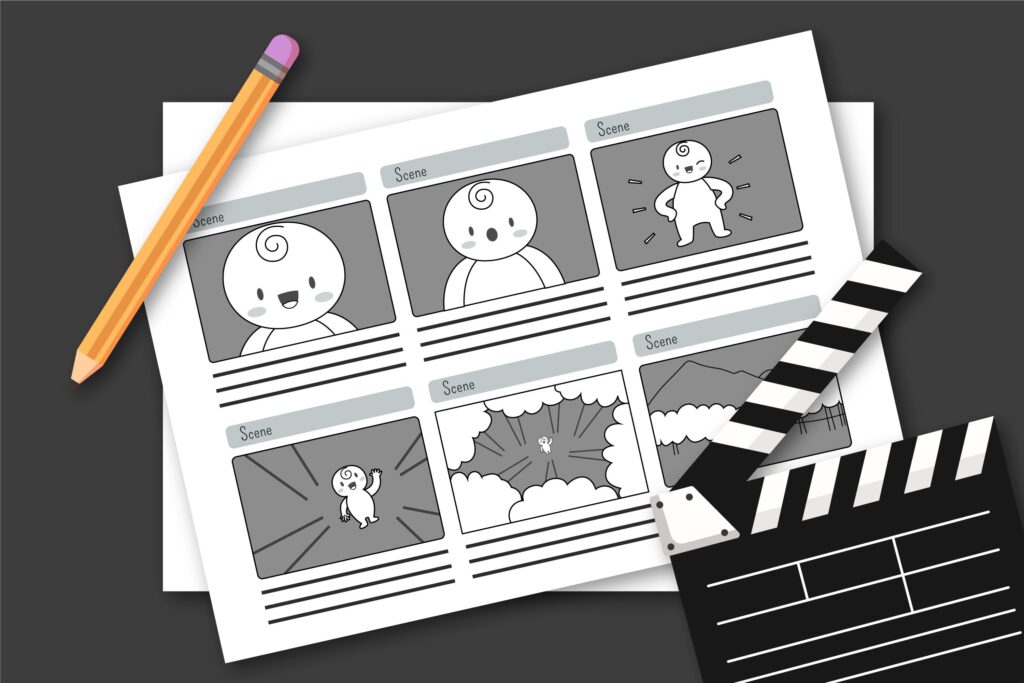
How to Develop a Character: A Step-by-Step Guide
Below is a toolbox to help you breathe life into your characters and, by extension, their character arc.
Identify Character Type
Start by knowing what role each character plays:
- Lead/Protagonist: They carry the story’s emotional weight. Their transformation defines the character arc.
- Supporting Characters: Allies, Rivals, Mentors. These characters help or hinder the protagonist. They add dimension and tension.
- Minor Characters: Brief appearances, but still require distinct motivations. Think spice, not the main course, but necessary for flavor.
Build a Character Profile
Create a mini profile to keep your characters consistent and real.
Include:
- Age, gender, ethnicity.
- Occupation and social class.
- Relationship status.
- Beliefs, values, and fears.
- Physical traits and habits.
- How they dress and carry themselves.
“What does this character want most? What do they need to learn to grow?” Diane Drake (What Women Want). These questions can crack your character wide open.
Think Dorothy from The Wizard of Oz, a dreamer stuck in Kansas, yearning for something more. That yearning? It drives her entire character arc.
Explore Backstory and Emotional Wounds
Every scar has a story. Your character’s past shapes their present.
- What trauma or triumph has molded them?
- What beliefs have hardened over time?
- How do their past experiences fuel their fears?
These are the soil where your character arc takes root.
Define Goals: External vs. Internal
Characters must want something. But even more importantly, they must need something.
- External Goals: Clear, visible, plot-driven. E.g. win a court case.
- Internal Goals: Emotional or spiritual growth. E.g. find self-worth, heal from grief.
Example: In Superbad, Seth wants to get laid (external), but he truly fears losing his best friend (internal). Without clear goals, characters become pawns to the plot. With them? They take the wheel.
Refine and Evolve as the Story Progresses
Characters should never be static. Just like real people, they grow with every decision and setback. As you revise:
- Check that their personality evolves based on events.
- Examine how their beliefs and values shift.
- Ensure all this movement leads to a believable, satisfying character arc.
Example: In Inside Out, Joy realizes that sadness is essential to growth. That shift is subtle but profound, and it completely reshapes her worldview.
Character Arc vs Story Arc – What’s the Difference?
Before diving deep, let’s clear the fog: a character arc is not the same as a story arc.
- Character Arc: The internal transformation your character undergoes. See it as an emotional or psychological journey.
- Story Arc: The sequence of events in your plot, the rising and falling action that frames the entire story.
While a story arc gives the tale its structure, the character arc gives it soul. Most great stories intertwine both arcs. As your plot intensifies, your characters evolve. Or sometimes they unravel.
What Is a Character Arc?
A character arc is your protagonist’s personal evolution from the person they were at the start of the story to who they become by the end.
In many cases, this arc is positive:
- They overcome internal flaws.
- They learn painful but necessary truths.
- They become better, braver, wiser, but not always.
Sometimes, characters fall from grace. Consider: Anakin Skywalker’s descent into Darth Vader. That’s a negative character arc, and when written well, it packs just as much punch, if not more.
The key? Internal change. Whether your hero learns to love or your villain slips deeper into shadow, something must shift within.
What Is a Story Arc?
If a character arc is the soul of your story, then the story arc is its framework. It’s the structure that holds everything together, the rise and fall, the tension and release.
Also known as a narrative arc, it charts the sequence of events that takes your reader from “Once upon a time” to “The End.”
Most classic story arcs follow a five-part structure:
- Exposition: The setup: who, what, where, and when. This is where we meet the characters and understand the world.
- Rising Action: The heartbeat races. Conflicts deepen. Stakes rise.
- Climax: The big explosion. The turning point. Everything hangs in the balance.
- Falling Action: The dust settles. Tension eases, and consequences play out.
- Resolution: Loose ends tie up. The final emotional chord is struck.
Every solid story needs a story arc, even if the character arc is minimal or flat. Why? Because without it, your plot becomes a flatline. It’s not just what happens; it’s how it unfolds.
How Character Arcs Drive Story Arcs
Here’s the magic: a compelling character arc often propels the story arc. Plot twists don’t happen in a vacuum. They happen to someone, someone who changes as a result.
For example:
- A character who’s terrified of vulnerability is forced into a situation where they must open up to survive.
- A selfish loner learns the value of sacrifice through a life-or-death moment.
As the plot escalates, your characters are challenged emotionally and morally. That tension between external events and internal change is where story gold lies.
Make Your Characters Unforgettable With a Strong Character Arc
A powerful character arc is the heartbeat of any story worth remembering. It draws readers in, holds them tight, and gives them something to root for or even fear.
At Quilltowers, we work with writers like you to breathe emotional depth into your fiction. Whether you’re plotting your first novel or refining a series, we’ll help you create arcs that crackle with life.
Let’s build stories that stay with readers long after “The End.” Reach out today.
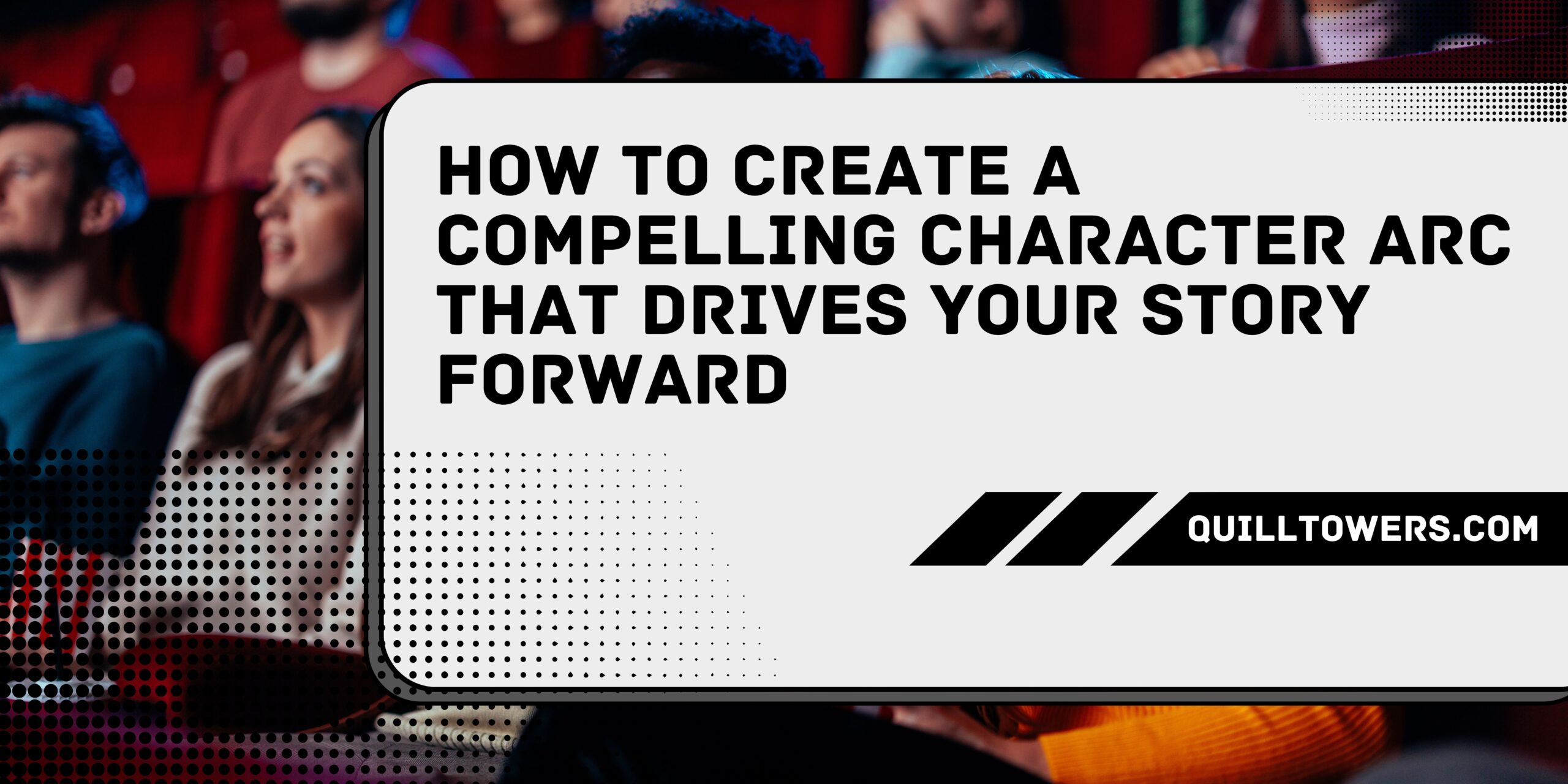
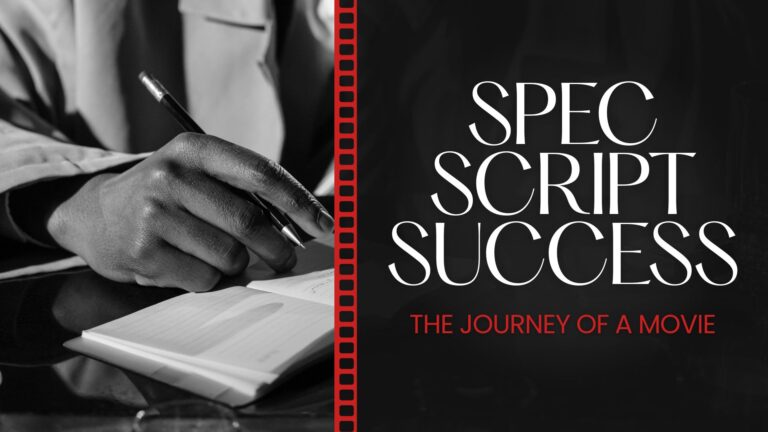



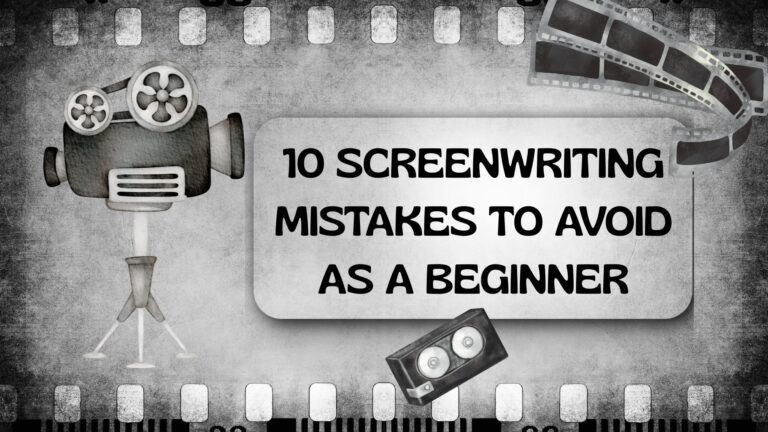
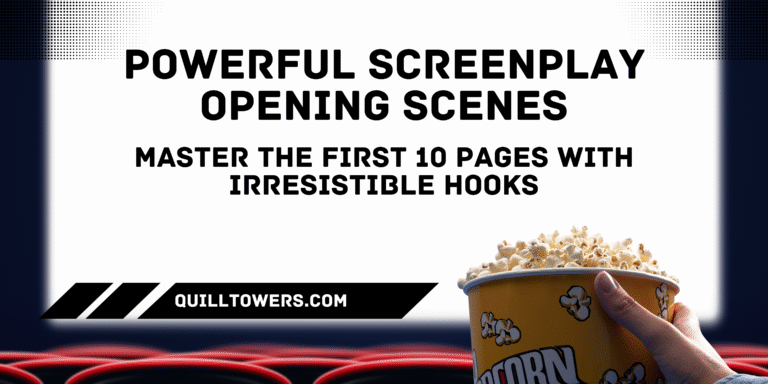
Your writing has a way of resonating with me on a deep level. I appreciate the honesty and authenticity you bring to every post. Thank you for sharing your journey with us.
This warms my heart greatly. Thanks for seeing the real me in my writing, it means everything to have readers like you!